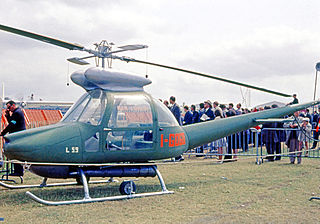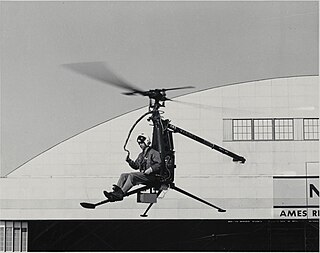
The Bell UH-1 Iroquois is a utility military helicopter designed and produced by the American aerospace company Bell Helicopter. It is the first member of the prolific Huey family, as well as the first turbine-powered helicopter in service with the United States military.

The Sikorsky CH-37 Mojave is an American large heavy-lift military helicopter of the 1950s. It entered service as the HR2S-1 Deuce with USMC in 1956, and as the H-37A Mojave with the U.S. Army that same year. In the early 1960s the designation was standardized to CH-37 for both services, with the HR2S-1 redesignated as CH-37C specifically.

The Sikorsky H-19 Chickasaw is a multi-purpose piston-engined helicopter that was used by the United States Army and United States Air Force. It was also license-built by Westland Aircraft as the Westland Whirlwind in the United Kingdom. United States Navy and United States Coast Guard models were designated HO4S, while those of the U.S. Marine Corps were designated HRS. In 1962, the U.S. Navy, U.S. Coast Guard and U.S. Marine Corps versions were all redesignated as H-19s like their U.S. Army and U.S. Air Force counterparts.
The Lualdi-Tassotti ES 53 was an Italian experimental helicopter designed by Carlo Lualdi around a Hiller-designed rotor system and a gyro stabiliser of his own design. It first flew at Campoformido in September 1953.
The Aer Lualdi L.55 was a prototype Italian helicopter, a development of the Lualdi-Tassotti ES 53 featuring a far more powerful 134 kW (180 hp) Lycoming O-360. While the ES 53 had been purely experimental, the L.55 was Lualdi's first step towards a marketable aircraft.
The Aer Lualdi L.57 was a prototype Italian helicopter, a further refinement of Lualdi's ES 53 and L.55 designs.

The Aer Lualdi L.59 was an Italian helicopter that failed to reach quantity production.

The Mil Mi-1 was a Soviet three- or four-seat light utility helicopter. It was the first Soviet helicopter to enter serial production. It is powered by one 575 hp (429 kW) Ivchenko AI-26V radial piston engine. It entered service in 1950 and was first seen on the 1951 Soviet Aviation Day, Tushino and was produced for 16 years. More than 1,000 were built in the USSR and 1,594 in Poland, as SM-1.

The Hiller YH-32 Hornet was an American ultralight helicopter built by Hiller Aircraft in the early 1950s. It was a small and unique design because it was powered by two Hiller 8RJ2B ramjet engines mounted on the rotor blade tips which weigh 13 lb (5.9 kg) each and deliver an equivalent of 45 hp (34 kW) for a total of 90

The Hiller OH-23 Raven is a two, three, or four-place, military light observation helicopter based on the Hiller Model 360. The Model 360 was designated by the company as the UH-12, which was first flown in 1948. Initially it was a two-place helicopter powered by a piston engine that entered service in the late 1940s, it went on to be a popular military and civilian light helicopter in the late 20th century.

A tip jet is a jet nozzle at the tip of some helicopter rotor blades, used to spin the rotor, much like a Catherine wheel firework. Tip jets replace the normal shaft drive and have the advantage of placing no torque on the airframe, thus not requiring the presence of a tail rotor. Some simple monocopters are composed of nothing but a single blade with a tip rocket.

The Bristol Type 173 was a British twin-engine, tandem rotor transport helicopter built by the Bristol Aeroplane Company. It was designed by Raoul Hafner as a civil transport helicopter but evoked interest from the military. It did not enter production but was developed into the Bristol Belvedere which was operated by the Royal Air Force from 1961 to 1969.

The Cessna CH-1 Skyhook is the only helicopter ever built by the Cessna Aircraft Company. It was the first helicopter to land on the summit of Pike's Peak and the last piston-engined helicopter to set the helicopter altitude record. The CH-1 had a single, two-bladed main rotor, and a front-mounted reciprocating engine which gave the aircraft a stable center of gravity (CG). Its semi-monocoque airframe greatly resembles its light airplane siblings built by Cessna. The CH-1 was named Skyhook for the civil market, similar to the marketing names used in the Cessna single engine airplane line, such as Skyhawk, Skylane and Skywagon. The United States Army designated the CH-1C as the YH-41 Seneca. While the CH-1 achieved several helicopter firsts and set a world record, it never became a commercial or military success.

The Bell R-12 was an American 1940s military utility helicopter built by the Bell Helicopter company. The design did not go into full production, but over a dozen prototypes were used for various tests and projects.

The BŻ-4 Żuk, formerly known as GIL-4, was a Polish four-seat light helicopter built in the 1950s. Although it pioneered a novel rotor and transmission system, it never entered series production.

The Doman LZ-5 was a utility helicopter developed in the United States in the early 1950s by Doman Helicopters Inc. of Danbury, Connecticut. Despite the procurement of international manufacturing agreements, no series production of the aircraft ever occurred, and only three prototypes were built. Two of these were purchased by the United States Army as the YH-31, but eventually becoming VH-31.
The Fiat Model 7002 was a 1960s Italian general-purpose helicopter with a tip jet driven rotor built by Fiat Aviazione. Only one aircraft was built.

The Bell Huey family of helicopters includes a wide range of civil and military aircraft produced since 1956 by Bell Helicopter. This H-1 family of aircraft includes the utility UH-1 Iroquois and the derivative AH-1 Cobra attack helicopter series and ranges from the XH-40 prototype, first flown in October 1956, to the 21st-century UH-1Y Venom and AH-1Z Viper. Although not flown in military service in the USA, the Bell 412 served in Canada and Japan and, like the UH-1Y, is a twin engine four rotor design based on the Bell 212.

The Hiller ROE Rotorcycle was a single-seat ultralight helicopter designed in 1953 for a military requirement. A total of 12 were produced for the United States Marine Corps. And in 1954, the Hiller Helicopters was selected by the US Navy's Bureau of Aeronautics to build this design of a one-man, foldable, self-rescue and observation helicopter. It featured a two-blade rotor system. Its original empty weight was 290 lb (132 kg).

The HZ-1 Aerocycle, also known as the YHO-2 and by the manufacturer's designation DH-5 Aerocycle, was an American one-man "personal helicopter" developed by de Lackner Helicopters in the mid-1950s. Intended to be operated by inexperienced pilots with a minimum of 20 minutes of instruction, the HZ-1 was expected to become a standard reconnaissance machine with the United States Army. Although early testing showed that the craft had promise for providing mobility on the atomic battlefield, more extensive evaluation proved that the aircraft was in fact too difficult to control for operation by untrained infantrymen, and after a pair of crashes the project was abandoned. A single model of the craft was put on display.















